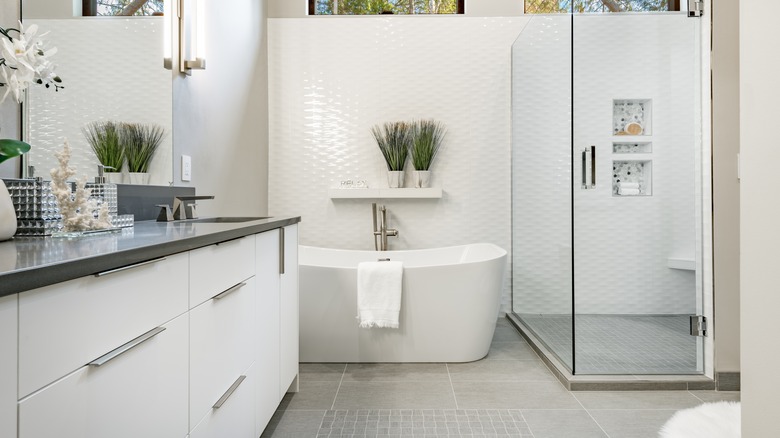The Easy-To-Forget Spot In Your Bathroom You've Likely Been Missing
Properly deep cleaning a bathroom takes many steps, so it's easy to overlook a detail or two. It entails everything from cleaning your bathtub jets to removing limescale from the showerhead and tossing dirty towels into the washing machine. With so many moving parts, it can be easy to overlook certain minor areas. And one such spot that you've likely been missing is the seams in your bathroom. These are the areas where two different elements meet, such as where the shower window meets the wall, the sink meets the counter, or the toilet meets the floor.
When cleaning, we often just quickly wipe down surfaces and reserve the scrubbing for places like the sink or shower floor. But a simple wipe doesn't usually extend to these seams, and grime begins to collect on them. After a while, this can lead to discoloration and bacteria buildup. To avoid that, you need to take the time to give them a thorough cleaning at least once a month.
How to clean the seams in your bathroom
If you regularly clean seams, you likely won't need anything more than a damp microfiber cloth and a cleaning spray to wipe down these connections. However, if it has been some time since you cleaned them, some areas might have stubborn buildup, and you will need to use a stiff bristle brush to tackle them. It would be best to use a nylon soft bristle brush since anything harsher could possibly remove caulking, grout, or other materials that could be adhering the seams together. It's also a good idea to use a thin brush to gain easier access to these tight spaces, such as the Scotch-Brite Grout Brush for $4 at Target.
As for which cleaning agent to use, it depends on the surface you are cleaning. Most surfaces can handle a multi-purpose spray or simple water and vinegar cleaning solution. However, if you have a marble countertop or cement tiles, you will have to be more careful cleaning the seams along those surfaces. Substances like vinegar can etch them, which will leave visible discoloration or scratches. Clean those areas with simple soap and water instead. Lastly, to clean the seams, all you have to do is dip your thin bristle brush into your mixture or douse the area with a spray bottle. Scrub at the buildup, and wipe away the grime with a clean and damp microfiber cloth.

